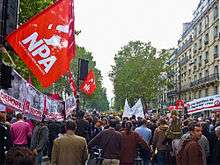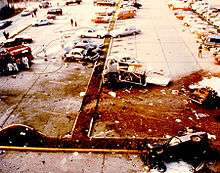Far-left politics
Far-left politics are politics further to the left of the left–right political spectrum than the standard political left.
| Part of the Politics series | ||||||
| Party politics | ||||||
|---|---|---|---|---|---|---|
| Political spectrum | ||||||
|
||||||
| Party platform | ||||||
|
||||||
| Party system | ||||||
|
|
||||||
| Coalition | ||||||
|
|
||||||
| Lists | ||||||
| Politics portal | ||||||
There are different definitions of the far-left. In certain instances, the term far-left or radical left has been associated with forms of anarchism, autonomism and communism. Groups that advocate for revolutionary anti-capitalism and anti-globalization have been characterized as far-left.
Extremist far-left politics can involve violent acts and the formation of far-left militant organizations meant to abolish capitalist systems and the upper ruling class. Far-left terrorism consists of groups that attempt to realize their radical ideals and bring about change through violence rather than established political processes.
Definition
The definitions of the far-left have varied in the literature, but there is a general consensus on the core characteristics that constitute the far-left. Scholars such as Luke March and Cas Mudde have proposed that socio-economic rights are at the radical left's core. Moreover, that the far-left is "left" with regard to how parties or groups describe economic inequality on the base of existing social and political arrangements.[1]
Luke March, Senior Lecturer in Soviet and post-Soviet Politics at Politics and International Relations of the University of Edinburgh, defines the far-left as those who position themselves to the left of social democracy which they see as insufficiently left-wing. The two main sub-types are called the radical left which desires fundamental changes in neoliberal capitalism and progressive reform of democracy such as direct democracy and the inclusion of marginalised communities; and the extreme left which denounces liberal democracy as a "compromise with bourgeois political forces" and defines capitalism more strictly. In his later conceptualization, March started to refer to far-left politics as radical left politics which is constituted of radical left parties that reject the socio-economic structures of contemporary society that are based on the principles and values of capitalism.[2]
Far-left politics is radical as it calls for fundamental change to the capitalist socio-economic structure of society.[3] March and Mudde claim that far-left parties are an increasingly stabilized political actor and are challenging mainstream social democratic parties. Further, they define other core characteristics of far-left politics as being internationalism, a focus on networking and solidarity, and opposition to globalization and neoliberalism.[3]
In Europe, the support for far-left politics comes from three overlapping groups, namely far-left subcultures, disaffected social democrats and protest voters—those who are opposed to their country's European Union membership.[4]
To distinguish the far-left from the moderate left, March and Mudde identify three useful criteria:
- Firstly, the far-left rejects the underlying socio-economic structure of contemporary capitalism.
- Secondly, they advocate alternative economic and power structures which involve the redistribution of resources from political elites.
- Thirdly, they are internationalists, seeing a causality between imperialism and globalism and regional socio-economic issues.[5]
Others classify the far-left under the category of populist socialist parties.[6] Some such as Professor Vít Hloušek and Professor Lubomír Kopeček of the Masaryk University at the International Institute of Political Science suggest secondary characteristics, including anti-Americanism, anti-globalization, opposition to NATO and in some cases a rejection of European integration.[7]

Luke March states that "compared with the international communist movement 30 years ago, the far left has undergone a process of profound de-radicalisation. The extreme left is marginal in most places". March identifies four major subgroups within contemporary European far-left politics, namely communists, democratic socialists, populist socialists and social populists.[8]
Far-left terrorism

Many far-left militant organizations were formed by members of existing political parties in the 1960s and 1970s[9] such as the Montoneros, the Red Army Faction and the Red Brigades.[10][11][12] These groups generally aim to overthrow capitalism and the wealthy ruling classes.[13]
See also
- Anarchism
- Category:Far-left political parties
- Hard left
- List of anti-capitalist and communist parties with national parliamentary representation
- Moonbat
- Ultra-leftism
References
- March, Luke; Mudde, Cas (1 April 2005). "What's Left of the Radical Left? The European Radical Left After 1989: Decline and Mutation". Comparative European Politics. 3 (1): 23–49. doi:10.1057/palgrave.cep.6110052. ISSN 1740-388X.
- Holzer, Jan; Mareš, Miroslav (2016). Challenges to Democracies in East Central Europe. Oxon: Routledge. p. 57. ISBN 9781138655966.
- March, Luke (1 September 2012). "Problems and perspectives of contemporary European radical left parties: Chasing a lost world or still a world to win?". International Critical Thought. 2 (3): 314–339. doi:10.1080/21598282.2012.706777. ISSN 2159-8282.
- Smaldone, William (2013). European Socialism: A Concise History with Documents. Lanham: Rowman & Littlefield Publishers. p. 304. ISBN 9781442209077.
- Hloušek, Vít; Kopeček, Lubomír (2010). Origin, Ideology and Transformation of Political Parties: East-Central and Western Europe Compared. Farnham: Ashgate. p. 46. ISBN 9780754678403.
- Katsambekis, Giorgos; Kioupkiolis, Alexandros (2019). The Populist Radical Left in Europe. Oxon: Routledge. p. 82. ISBN 978-1-138-74480-6.
- Hloušek, Vít; Kopeček, Lubomír (2010). Origin, Ideology and Transformation of Political Parties: East-Central and Western Europe Compared. Farnham: Ashgate. p. 46. ISBN 9780754678403.
- March, Luke (2008). Contemporary Far Left Parties in Europe: From Marxism to the Mainstream? (PDF). Berlin: Friedrich-Ebert-Stiftung. p. 3. ISBN 9783868720006. Retrieved 3 June 2017.
- Pedahzur, Ami; Perliger, Arie; Weinberg, Leonard (2009). Political Parties and Terrorist Groups (2nd ed.). London: Routledge. p. 53. ISBN 9781135973377.
- Raufer, Xavier (October–December 1993). "The Red Brigades: A Farewell to Arms". Studies in Conflict and Terrorism. 16 (4): 315–325. doi:10.1080/10576109308435937.
- "Red Brigades announce end of their struggle to overthrow German state". The Irish Times. 22 April 1998. Retrieved 1 April 2020.
German detectives yesterday confirmed as authentic a declaration by the Red Army Faction (RAF) terrorist group that its struggle to overthrow the German state is over.
- Chaliand, Gérard (2010). The History of Terrorism: From Antiquity to Al Qaeda. Berkeley: University of California Press. ISBN 9780520247093.
- "Red Brigades". CISAC. Stanford University. May 2008. Retrieved 1 April 2020.
The PL [Prima Linea] sought to overthrow the capitalist state in Italy and replace it with a dictatorship of the proletariat.
Further reading
- Chiocchetti, Paolo (2016). The Radical Left Party Family in Western Europe, 1989–2015 (1st ed.). London: Routledge. p. 244. ISBN 9781138656185.
External links
